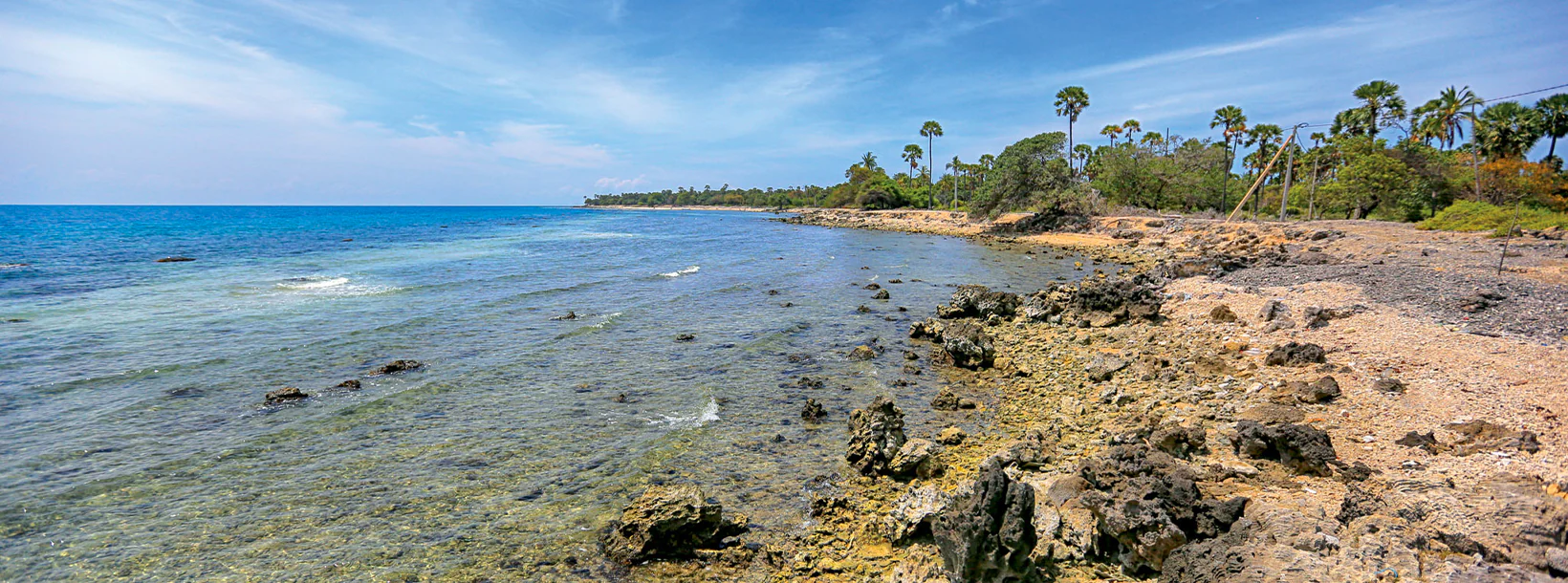
Delft Island
Delft Island, off Sri Lanka's northern coast, is known for its unique features, including coral walls, wild ponies, and ancient baobab trees. The island's rich history is reflected in its colonial ruins, such as a Dutch fort and Portuguese church, making it a fascinating destination for history enthusiasts and those seeking a serene, off-the-beaten-path experience in the Jaffna Peninsula.
The Giant Footprint
Queens Tower is in the very south-east of Delft Island, travelling from there along the southern coastline you will arrive at the village called Sarapiddi close to the western coastline. Sarapiddi is located halfway between Queens Tower and the Dutch fort and not far from the stupa called Cholan Ruins, alias Vediyarasan Fort.
Sarapiddi does not really look like a village. It's a settlement area, with dispersed inhabited houses and some gardening areas in between them. Sarapiddi is the perfect place to study the coral walls surrounding private properties, typical for Delft Island. Fences used as enclosures of premises are typical for Tamil settlements all over the Jaffna peninsula. However, coral walls instead of fences are something special. Their appearance resembles Irish sceneries more than Tamil settlements. And this is not by accident, as we shall see below. That Sarapiddi is known for the best freshwater, is also connected with the story of the coral walls. Travellers usually stop at Sarapiddi to walk to the the ruins of a stable complex close to the village.
On the way to the ruins of those horse stable, visitors come along the so-called "Giant's footprint". It is engraved on the stone surface. It is said to have been left by a man who must have been about 13 meters tall. A similar footprint on the island of Nainativu is attributed to the second of the Buddha's three legendary visits in Sri Lanka. However, the Hindu population of Delft credits Hanuman with leaving the footprint in Sarapiddi. The monkey-faced Hanuman was the helper of Rama and came to Sri Lanka several times, flying through the air just like the Buddha. The first time he was on the Island of Lanka in search for Rama's abducted wife Sita. He came again with Rama's monkey army to free Sita. And during the war he had to travel to the Himalayas in search for medical herbs needed for curing Rama's and Lakshmana's otherwise fatal wounds. According to some Hindu beliefs, the entire island of Delft had been created by a piece of the Himalaya mountains that the god Hanuman had been carrying when returning to Sri Lanka, a story supposed to explain the occurence of 62 species of Ayurvedic plants on Delft Island. But usually it's the smaller island of Kachchaitivu which is regarded to be this so-called "Sanjeewani drop" in the Indian Ocean. However, on one of his visits Hanuman must have arrived on Delft or started his giant jump back to India from here. What else could be the cause of the giant footprint?
About Jaffna District
Jaffna is the capital city of the Northern Province, Sri Lanka. 85% of the populations of the Jaffna and Kilinochchi districts are Hindus. The Hindus follow the Saivite tradition. The remainders are largely Roman Catholics or Protestants, some of whom are descendants of colonial settlers, known as Burghers. The Tamils are divided along caste lines, with the farmer-caste Vellalar forming the majority. Sea products, red onion, and tobacco are the main products in Jaffna.
Jaffna is home to beautiful Hindu temples. An Old Dutch Fort still stands well preserved within which is an old Church. Another example of Dutch architecture is the King's House. No visit to Jaffna is complete without tasting the exquisite Jaffna mango, reputed for its sweetness. About 3 km away is the majestic Nallur Kandaswamy Temple, home to the largest religious festival in Jaffna. The Kayts Harbour is an ancient ship docking site in the Jaffna region.
About Northern Province
The Northern Province is one of the 9 provinces of Sri Lanka. The provinces have existed since the 19th century but they didn't have any legal status until 1987 when the 13th Amendment to the 1978 Constitution of Sri Lanka established provincial councils. Between 1988 and 2006 the province was temporarily merged with the Eastern Province to form the North-East Province. The capital of the province is Jaffna.
Northern Province is located in the north of Sri Lanka and is just 22 miles (35 km) from India. The province is surrounded by the Gulf of Mannar and Palk Bay to the west, Palk Strait to the north, the Bay of Bengal to the east and the Eastern, North Central and North Western provinces to the south.The province has a number of lagoons, the largest being Jaffna Lagoon, Nanthi Kadal, Chundikkulam Lagoon, Vadamarachchi Lagoon, Uppu Aru Lagoon, Kokkilai lagoon, Nai Aru Lagoon and Chalai Lagoon.Most of the islands around Sri Lanka are to be found to the west of the Northern Province. The largest islands are: Kayts, Neduntivu, Karaitivu, Pungudutivu and Mandativu.
The Northern Province's population was 1,311,776 in 2007. The majority of the populations are Sri Lankan Tamils, with a minority Sri Lankan Moor and Sinhalese population. Sri Lankan Tamil is the major language spoken in the province by the vast majority of the population. The other language spoken is Sinhala by 1 percent of the population. English is widely spoken and understood in the cities.










